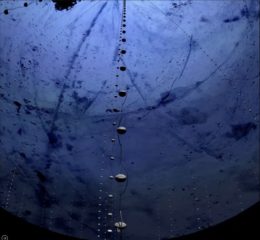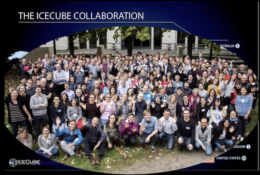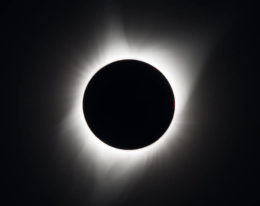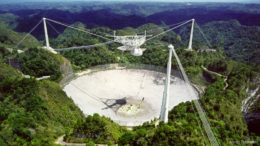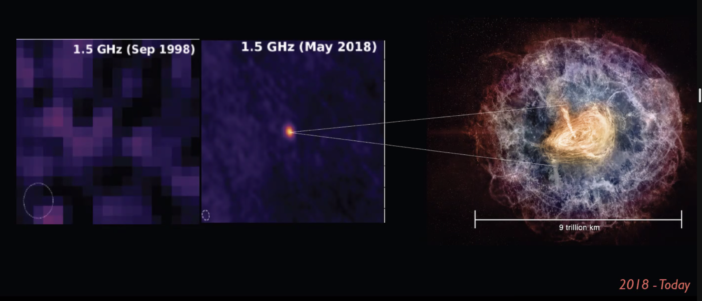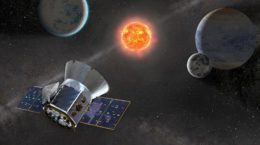Editor’s Note: This week we’re at the 240th AAS meeting in Pasadena, CA, and online. Along with a team of authors from Astrobites, we will be writing updates on selected events at the meeting and posting each day. Follow along here or at astrobites.com for daily summaries, or follow @astrobites on Twitter for live coverage. The usual posting schedule for AAS Nova will resume on June 21st.
Table of Contents:
- High Energy Astrophysics Division Bruno Rossi Prize: Francis Halzen (University of Wisconsin-Madison)
- Press Conference: Stars, Their Environments & Their Planets
- Helen B. Warner Prize: Rebekah Dawson (Pennsylvania State University)
- Preparing for the North American Solar Eclipses of 2023 and 2024
- The Arecibo Observatory, An Engine For Science and Scientists In Puerto Rico And Beyond
- Press Conference: Extragalactic Investigations & Evolved Stars
- Annie Jump Cannon Award Lecture: Laura Kreidberg (Max Planck Institute for Astronomy)
- Newton Lacy Pierce Prize: Courtney Dressing (University of California at Berkeley)
- SOFIA Town Hall
High Energy Astrophysics Division Bruno Rossi Prize: Francis Halzen (University of Wisconsin-Madison) (by Luna Zagorac)
Deep in the Antarctic ice, 86 columns of photomultiplier tubes are buried like strings of fairy lights. These strings don’t produce light, but instead capture the smallest numbers of photons produced by passing particles called muons and neutrinos. Of these events, there are about 1011 muons per year, close to 105 atmospheric neutrinos, and only about 200 cosmic neutrinos.Together, this kilometer cube of ice and electronics make up the Ice Cube Neutrino Observatory. Consisting of more than 300 people from 14 countries, the IceCube collaboration is helmed by Professor Francis Halzen and is the 2020 recipient of the HEAD Bruno Rossi Prize. The prize comes on the heels of the discovery of the 200-odd cosmic neutrinos — neutrinos produced outside our own galaxy! — which may hold the key to revealing the origins of cosmic rays.
Indeed, 10 years of IceCube data show a non-uniform sky map, with four main sources of cosmic neutrinos: NGC 1068, OKS 1424+240, TXS 0506, & GB9. Most of these sources are active galactic nuclei, with cores and jets energetic enough to accelerate cosmic neutrinos sufficiently that they eventually reach Earth and IceCube. Furthermore, some of these sources also show optical flares (such as that of TXS 0506 in 2014) corresponding to their neutrino flares. This is particularly exciting since the Universe outside of our own galaxy is opaque to the most energetic photons, or gamma rays. Thus, neutrino astronomy opens new avenues for doing multi-messenger astronomy at different energies when studying sources like these.The most recent IceCube analyses of these sources are still embargoed, so we were not able to learn whether these four objects are sources of cosmic rays or weird statistical fluctuations in neutrino numbers. However, Professor Halzen noted with a smirk that we would not be discussing them if they weren’t interesting. The most important take-away from the plenary, then, is that neutrino astronomy exists and that multi-messenger astronomy is closing in on cosmic ray sources. We should all stay tuned!
See live-tweets of this session here, by Luna Zagorac.
Stars, Their Environments & Their Planets (by Macy Huston)
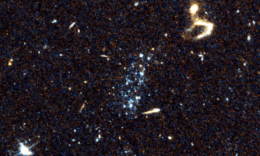
Hubble image of a “blue blob” star system. [Michael Jones]
Next up is “A Survey of Pre-Main-Sequence Stars and Massive T Tauri Protoplanetary Disks with the Gemini Planet Imager” from Evan Rich of the University of Michigan. We know that planets form around young stars in disks, which are composed of gas, small dust, and large dust. This process is difficult to study though, as it is difficult to image planets in the formation process with current technology. This team is working to indirectly trace planet formation through its effect on small dust grains. Radiation from small dust in disks is polarized, while starlight is not, so the overwhelmingly bright starlight can be filtered out of these observations. The Gemini LIGHTS project is uniquely observing stars more massive than our Sun. Stars three times the mass of the Sun do not show any apparent ring structures, which are typically indicative of planet formation. There are a few possible causes for this: the effects of binary companions, higher temperatures, observational bias, or the systems being too young to form rings. This leaves us with an interesting open question: Does stellar mass play an important role in the planet formation process? Press release (University of Michigan) | Press release (NOIRLab)
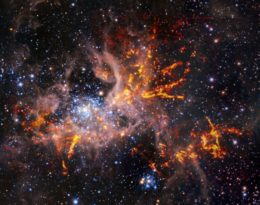
Composite infrared and radio image of the star-forming region 30 Doradus, also known as the Tarantula Nebula. [ESO, ALMA (ESO/NAOJ/NRAO)/Wong et al., ESO/M.-R. Cioni/VISTA Magellanic Cloud survey. Acknowledgment: Cambridge Astronomical Survey Unit]
The fourth presentation of the session was “Far-Ultraviolet Flares on AU Mic and the Implications for Its Planets” from Adina Feinstein of the University of Chicago. Thousands of exoplanets have been discovered to date, but most of these planets are very old. The 12 known planets that are less than 100 million years old have sizes in the range from Neptune to Jupiter, while most known transiting planets are between Earth and Neptune’s sizes. Young planets live in highly irradiated environments, subject to flares from their young stellar hosts. The team acquired Hubble observations of AU Mic, a roughly 22 million year old system with 2 close-in transiting exoplanets. The Hubble light curve shows 13 flares, or 2.5 flares per hour, an extremely high rate! These powerful flares can rip material away from their planets. Interestingly, the flares show a surprising increase in far-UV flux, compared to longer wavelengths. So, young stars show powerful flares which can cause high mass-loss rates in their planets, but the extent of this contribution is still an open question. Atmospheric characterization of planets undergoing mass loss is hard due to stellar activity, but the field is making progress toward making this possible.

Illustration of two rocky planets orbiting an M dwarf. [NASA/JPL/Caltech]
See live-tweets of this session here, by Macy Huston.
Helen B. Warner Prize: Rebekah Dawson (Pennsylvania State University) (by Macy Huston)
The 2021 Helen B. Warner Prize recipient is Professor Rebekah Dawson from Penn State University. Today, she presented a talk titled “Multifaceted Views of Planetary Systems.” The textbook version of planet formation proposes that rocky planets form close in, while gas giants form further out, based on the structure of our solar system, where planets are on circular and aligned orbits. However, even in the solar system, this formation theory isn’t the complete picture.
Early exoplanet discoveries revealed systems very different from our own, like hot Jupiters and planets on highly elliptical and misaligned orbits. Three different theories have been proposed as a formation mechanism of close-in giant planets: in situ formation, disk migration, and tidal migration. Astronomers have found hundreds of these planets now, so these theories can be tested.
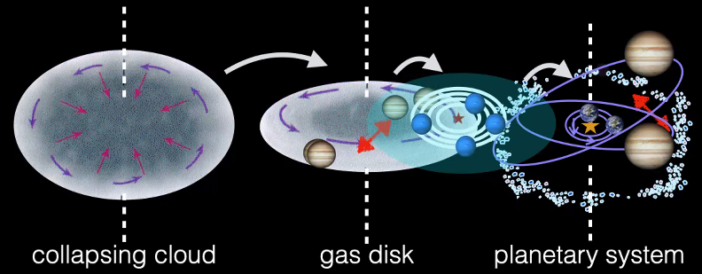
Stages of planet formation: collapsing cloud, then gas disk, then planetary system [Image from Rebekah Dawson’s slides]
Evidence shows that, contrary to the textbook version of planetary system origins, gas giants may form or migrate closer-in to their stars. Additionally, planets interact with gas, solids, and each other. Transit studies have shown that super-Earth-sized planets are common. Planets from the size of Earth to Neptune show a wide range of different compositions. Multi-transiting planet systems are typically “dynamically cold,” perhaps even more flat and circular in orbit than we might expect. These systems can be surprisingly tightly packed and similar (in mass, size, spacing), as well as in resonant chain orbits.
Just like close-in giant planets, there are many theories for the formation of close-in super-Earths/mini-Neptunes. Today, Prof. Dawson focused on the in situ formation mechanism. Terrestrial planets are thought to form in the inner disk once gas has mostly cleared out of the system. However, gas has been detected in some disk “cavities.” Perhaps an intermediate era where some gas is still present is when super-Earths form. In situ formation of super-Earth/mini-Neptune planets requires more solids in inner disks than initially expected. The diversity of planet compositions may be due to variations in disk solids in different systems.
We see two different modes of formation for these planetary systems: dynamically cold (low density planets, tight/uniform systems, formed with residual gas) and dynamically hot (rocky planets, more spacing and orbital variation, formed after the gas stage). Resonant chain systems can form three different ways: long scale migration, short scale migration, and eccentricity damping. And this brings us to a summary of the multi-faceted properties of close-in super Earths. Overall, the origins of planetary systems are much more complicated than we may have thought before discovering a large number of exoplanets. Current and upcoming missions are closing the gaps between the sensitivity ranges of different exoplanet detection methods. Prof. Dawson wrapped up her talk with a vision of the future, and how current and upcoming missions will enable multi-faceted views of more systems.
See live-tweets of this session here, by Macy Huston.
Preparing for the North American Solar Eclipses of 2023 and 2024 (by Abby Lee)
The main thrust of this session was the preparation for the two upcoming solar eclipses. The first upcoming eclipse will occur on October 14, 2023, and is an annular solar eclipse, which is when the Moon does not completely cover the Sun and you can see the classic “ring of fire” (which is actually the Sun’s photosphere). The second is happening on April 8, 2024, and will be a total solar eclipse, which is when the Moon completely obscures the Sun (you may remember the last total solar eclipse that happened in North America in 2017!). The speaker (Rick Fienberg, former AAS press officer and member of the AAS Solar Eclipse Task Force) emphasized that everyone should try to see a total solar eclipse at least once in their lifetime because it is “completely life-changing.” Eclipses are incredible coincidences because the Sun is the same angular size as the Moon — in 500 million years, we will no longer see total eclipses because the Moon is drifting away from Earth by about 4 cm per year!In 2014, AAS created a task force to engage as many Americans as possible with solar eclipses. Their main working groups focus on organizing outreach and education events with local communities, working with local press, doing museum work, and communicating with local transportation officials (because traffic can get really bad during eclipses!). All of the information for this task force can be found at their website.
The task force’s number one priority is safety and the distribution of glasses. Looking at an annular solar eclipse or partial solar eclipse can physically or chemically burn your retinas permanently, so you need glasses made of special material in order to protect them. Though over 300 million Americans viewed the solar eclipse in 2017, only a couple dozen people suffered (temporary) retina damage due to looking at the Sun. This was due in large part to the hard work of the AAS Solar Eclipse Task Force, who worked diligently to educating the public on eye safety during the eclipse and with glasses distributors to make sure they were compliant with safety regulations. There are non-reputable sellers on Amazon, so make sure you buy from a trusted source. The task force recommends visiting their website for a list of reputable eyewear vendors.
If you are interested in getting involved with the AAS Solar Eclipse Task Force, visit their website! There are many opportunities for outreach including formal K-12 education groups, informal social media groups, and helping to prepare communities in the path of totality.
See live-tweets of this session here, by Abby Lee.
The Arecibo Observatory, An Engine For Science and Scientists In Puerto Rico And Beyond (by Graham Doskoch)
The collapse of the 305-meter dish at the Arecibo Observatory on December 1, 2020, was a huge tragedy for scientists around the world. Completed in 1963, the enormous structure was the largest single-dish telescope in the world for over half a century. Over 57 years, it made groundbreaking contributions in three primary fields: planetary science, radio astronomy, and atmospheric science. In the aftermath of its loss, both the scientific and Puerto Rican communities have reflected on its legacy and worked to preserve the observatory’s future. Today’s splinter session served as both an emotional, personal eulogy to the telescope and a reflection on the work that lies ahead to maintain the world-class science still being done at the Arecibo Observatory.After an introduction by Dr. Nicole Lloyd-Ronning, the first portion of the session was led by Dr. Francisco Córdova, director of the observatory since 2018, who first provided a summary of the 305-meter dish’s significant accomplishments. Arecibo played an instrumental role in the measurement of the rotation rate of Mercury, the detection of the first exoplanets, and the observation of the first repeating fast radio bursts. Additionally, the observatory has — and continues — numerous outreach programs, including an REU (Research Experiences for Undergraduates), AOSA (Arecibo Observatory Space Academy), and the STAR Academy.
After listing the telescope’s major contributions, Dr. Córdova gave a detailed update on the work being done at Arecibo in the wake of the collapse. He announced that the majority of the cleanup efforts have been completed. A second forensic report on the collapse will be released by the end of the third quarter of 2022. While the dish may be gone, plenty of cutting-edge science is still being done, including ongoing observations with the 12-meter dish and work in the observatory’s lidar (light detection and ranging system) and optical labs. The visitor’s center, a major scientific attraction in Puerto Rico, has also been reopened. In conjunction with this, outreach efforts have been continued, and the staff are investigating potential new capabilities for the observatory to explore, including a possible replacement for the 305-meter dish.
The remainder of the session was devoted to a panel discussion, mediated by Prof. Marcel Agüeros of Columbia University. The four panelists were Viviana Vélez, an undergraduate who participated in the STAR Academy, Dr. Thankful Cromartie, a postdoc at Cornell University who was an REU student at Arecibo, Dr. Carlos Padín, of the Universidad Ada G. Méndez, and Dr. Allison Smith, a postdoc at Arecibo. Vélez and Cromartie both spoke about their experiences as student participants in Arecibo’s outreach programs; Vélez noted that the STAR Academy “inspires students to keep on dreaming.” Cromatie revealed that her summer at Arecibo “shaped everything I’ve done in science since then,” as it stimulated her love of pulsars and led to her meeting her future PhD advisor.
Smith and Padín both spoke at length about their involvement in education and public outreach (EPO) at the observatory. Padín demonstrated the popularity and reach of Arecibo outreach efforts by providing statistics about the numerous applicants to the observatory’s various programs. The major programs include the REU, the STAR Academy, and AOSA but in addition, Arecibo has observatory nights, the Girls Educating Girls mentorship programs, and of course the ever-popular visitor’s center, which has welcomed hundreds of thousands of visitors, many of them schoolchildren from around Puerto Rico. The experience of visiting Arecibo stays with people; Padín mentioned that “a person stopped by our [AAS] booth and said, ‘I was there when I was 9 years old.’” When people first see the dish, he says, “There’s always that ‘Woooow!’”
Smith related how she became acquainted with Arecibo firsthand not as a postdoc but as a graduate student, attending the single-dish summer school the observatory runs jointly with the Green Bank Observatory in West Virginia. Unlike the observatory’s other programs, it’s more technical, aimed at graduate students performing research in radio astronomy. Smith is now involved with the coordination of the program — a challenge now that the pandemic has forced the summer school to go online and hybrid.
All four panelists were asked about their thoughts on the observatory’s future. Vélez said she hopes the observatory keeps going with its EPO efforts and eventually builds a replacement for the 305-meter dish. Cromartie echoed the sentiment, and also advocated for additional use of the other on-site facilities. Padín described plans to integrate the arts into future EPO projects, and noted that Arecibo will need more funding to keep its programs going. “The future is bright,” Smith said when describing a proposal for an “advanced REU program,” wherein undergraduate students would do additional work on research projects throughout the academic year, culminating in summer work on-site at the observatory. “Arecibo has been a model for EPO programs,” she said. “There’s nothing more exciting than coming to a place like the Arecibo Observatory when you’re a student.” Agüeros finished the discussion by mentioning how the Puerto Rican community has gained a sense of ownership of the observatory over the past two decades, given its importance to the community.
Prof. Héctor Arce of Yale University, who gave a plenary lecture on Arecibo on Monday, concluded the session by noting that the observatory practices “outreach inspiring outreach.” The world-class research performed at a world-class facility strengthened the impact of the site’s EPO programs. At the same time, he said, “The observatory is made by the people.” As long as Arecibo’s scientists continue to make groundbreaking contributions to science — particularly if a replacement for the 305-meter dish is built — Arecibo’s legacy will endure.
Press Conference: Extragalactic Investigations & Evolved Stars (by Sabina Sagynbayeva)
The first speaker was Dr. Valeria Olivares from the University of Kentucky with a presentation titled “Black hole activity is not evolving in central cluster galaxies.” Galaxy clusters are the most massive systems of the universe. In a galaxy cluster, a massive central elliptical galaxy sits at the center, which generally hosts an active black hole. Some of these clusters are rapidly cooling, with strong X-ray emissions at the center. So, Dr. Olivares and collaborators looked at the evolution of black holes in a sample of 164 galaxy clusters from the Planck telescope. The interaction between a supermassive black hole and its host galaxy in clusters has been in place since 8 billion years ago, and since then has evolved mildly. However, future high resolution X-ray observations can find more cavities in the faintest clusters and confirm their findings in high redshift clusters. Press release
The next speaker was Dillon Dong from Caltech presenting the Discovery of an Extremely Luminous, Decades-Old Pulsar Wind Nebula in the Very Large Array Sky Survey. The story begins with a galaxy far away… a star collapsed and became a magnetically active neutron star! Another star also blew up in a supernova around the neutron star, launching its guts outwards and creating a supernova remnant. Using the Very Large Array Sky Survey, Dong and his team discovered this emerging wind nebula as a radio transient. Explosive radio transients have never before been observed with such flat spectra. They noticed two clues: the transient is located in the central star cluster of a dwarf starburst galaxy, and it is almost as luminous as fast radio bursts. This transient turned out to be potentially the youngest known pulsar (or magnetar) wind nebula! As the remnant material expanded, it eventually became transparent to radio waves only a few decades ago. Press release
Thirdly, Dr. Curtis McCully (Las Cumbres Observatory) presented some Models for the Late-Time Excess Flux of a Peculiar Supernova! Dr. McCully and collaborators were looking at the supernova 2012Z (SN 2012Z) in the galaxy NGC 1309 and were surprised to find that the star that exploded was not destroyed. It survived and became brighter! NASA’s Hubble Space Telescope observed NGC 1309 — SN 2012Z’s host galaxy — in 2005, 2006, and 2010, before the supernova outburst. The group reprocessed the pre-explosion images to make them sharper and noticed an object at the supernova’s position. The source in the pre-explosion image was likely a combination of the companion star that was donating mass to a white dwarf and the disk of material around the white dwarf. The best explanation for why the supernova has not faded as expected is that we are seeing a combination of the shell of material that was ejected from the white dwarf and a heated remnant of the white dwarf that did not fully explode. Press release The next talk was about The Proper Motion of a Pulsar in a Galactic Supernova Remnant by Dr. Xi Long and Dr. Paul Plucinsky (Center for Astrophysics | Harvard & Smithsonian). The group measured the first direct proper motion of a pulsar: 612 km/s (1.4 million miles per hour)! The pulsar’s location is G292.0+1.8, an oxygen rich galactic supernova remnant about 2,000 years old. The kick direction is ~126° and the jet direction is nearly north-south aligned, which is consistent with random spin-kick alignment from simulations and is also consistent with the neutrino driven explosion mechanism for core collapse supernovae from simulations. Press releaseThe last speaker was Ted Johnson (University of California, Los Angeles) describing some Strange Abundances in a White Dwarf: Evidence for Simultaneous Accretion of Rocky and Icy Bodies. Ted’s team found the first evidence for a white dwarf star consuming two distinct objects! Roughly 30% of white dwarfs are “polluted” by planetary material. Hence, they become a great planetary laboratory — you can learn about planetary composition and formation from a white dwarf’s lunch. They looked at the white dwarf’s composition and noticed something interesting: it mostly has a mix of icy and rocky-metallic material. Their interpretation of this result was that the white dwarf might be accreting an icy Kuiper belt object body and a Mercury-like asteroid. Press release (UCLA) | Press release (STScI)
See live-tweets of this session here, by Sabina Sagynbayeva.
Annie Jump Cannon Award Lecture: Laura Kreidberg (Max Planck Institute for Astronomy) (by Pratik Gandhi)
This year’s Annie Jump Cannon Award was given to Dr. Laura Kreidberg for her seminal work on characterizing exoplanet atmospheres. In her plenary lecture titled “Planets are places: characterization of other worlds in the 2020s and beyond,” Dr. Kreidberg discussed the contributions of Annie Jump Cannon to the field of astronomy, the importance of studying exoplanet atmospheres, and the main frontiers remaining to be addressed in this field. Dr. Kreidberg is the Director of the Atmospheric Physics of Exoplanets (APEx) Department at the Max Planck Institute for Astronomy in Heidelberg, Germany.
To begin, Dr. Kreidberg drew the audience’s attention to the legacy of Annie Jump Cannon, a pioneer in stellar classification. Her OBAFGKM scheme for classifying stellar spectral types remains in use to this day! “She was also profoundly hard of hearing, and experienced enormous discrimination,” said Dr. Kreidberg.
Of the 5,000+ known exoplanets, many can be assigned to two populations that we don’t see in our solar system. We call these planets Hot Jupiters and super-Earths/sub-Neptunes, although Dr. Kreidberg also suggests the term “Neptini”! Dr. Kreidberg adds that now is a great time to be working on exoplanet atmospheres and characterization, and that studying their atmospheres can inform our knowledge of the exoplanets’ formation and prospects for life elsewhere in the universe!
As far as exoplanet atmospheres are concerned, we can often characterize them using a basic technique called “Transmission/Emission Spectroscopy”. This is possible whenever the planet passes in front of or behind the star — starlight gets filtered through the planet’s atmosphere, leaving an imprint of the chemical composition of the atmosphere on the star’s spectrum. Moving on, she talks about the four main frontiers in this field:
Frontier #1: what can we learn about planet formation from planetary atmospheres? Gas giant planets in particular retain a fairly pristine atmosphere that reflects the conditions of when the planet first started forming. Dr. Kreidberg adds that over the past few years, the Hubble Space Telescope has really transformed the study of water and oxygen abundances in planetary atmospheres, especially in Hot Jupiters! There are some interesting outliers though — KELT-11b is a planet with 100 times less atmospheric water than expected from compositions in the solar system. This kind of low water content could point to planet formation by pebbles and not planetesimals, because gas is wet and pebbles are dry.
Frontiers #2-#3: what can we learn about Earth from its cousins? Studying sub-Neptunes could allow us to study volatile element delivery to small rocky bodies, as might have happened with the proto-Earth. Dr. Kreidberg then pointed to a result from 2014 of a warm “Neptino” with a spectrum so featureless that there must have been clouds or haze in the planet’s atmosphere, which is extremely cool!
Note that one “shortcut” to determining whether a small rocky planet has an atmosphere is thermal phase curve observations — presence of an atmosphere tends to even out temperatures between the day and night sides of the planet, which can be a useful probe! Dr.Kreidberg added that JWST observations will be extremely exciting for exploring the diversity of rocky exoplanet atmospheres around M-dwarf stars! More than 10 rocky exoplanets are scheduled to undergo JWST observations, and chemical features could be detectable!
Finally, the plenary wrapped up with Dr. Kreidberg speculating on Frontier #4: when will we detect biosignatures? She encouraged a little caution — even with JWST etc, we may not have the capacity currently to detect biosignatures in exoplanet atmospheres. A next generation space telescope is needed, which is a priority for the 2020 Decadal Review!
See live-tweets of this session here, by Pratik Gandhi.
Newton Lacy Pierce Prize: Courtney Dressing (University of California at Berkeley) (by Isabella Trierweiler)
In her plenary talk, Dr. Courtney Dressing (an Astrobites founder!) took us on a tour through three exoplanets, each in a multiplanet system. One of the most common ways to detect exoplanets is the transit method, which searches for the dip in starlight that occurs when a planet passes in front of its host star. NASA’s Transiting Exoplanet Survey Satellite (TESS) uses the transit method to search for planets all over the sky, and has found over 5000 new candidates. Since the last in-person AAS meeting (in 2020), the number of exoplanets discovered has increased by a whopping 20%! Dr. Dressing emphasizes that in addition to simply detecting more planets, we need to build a sample set of well-studied planets with data applicable to multiple scientific disciplines. This is the goal of the TESS-Keck Survey (TKS), which will build a database of exoplanets including bulk compositions, atmospheric masses and compositions, planetary architectures, and systems around evolved stars.We start the tour at K2-136c, which is unique as it is one of the few young planets with a density estimate. It’s about twice as dense as Neptune, and a little less dense than Earth. While we can’t get an exact composition with just bulk density measurements, one possible composition for this planet is a rocky core with a hydrogen/helium atmosphere.
Up next is HIP 41378f, part of a five-planet system. This planet is remarkable for having very low density. It’s a little unclear what makes the density so low — the planet might have a ring system, or it could be a super-puff planet, or have an atmosphere. There actually are several planets with similar low densities. Taken as a group, rings are not able to explain all of these planets, but hazes in the atmosphere could be the solution, and Dr. Dressing hopes to use upcoming JWST observations to confirm this.
The last stop on the tour is TOI-1246, a system that has extensive data from adaptive optics imaging, radial velocity, and transit detection. With all this data, Dr. Dressing’s team found a surprise — an extra planet hidden in the radial velocity signals! While the mass of this extra planet is not well known, it is accompanied by four sub-Neptunes in the system. The architecture of this system is somewhat unusual, in that it does not follow the “peas-in-a-pod” arrangement of most exoplanet systems, and instead shows a gap between the inner and outer planets.
In the last bit of her talk, Dr. Dressing discussed future efforts towards understanding habitability, a topic that was named as a focus point for the next decade by both the Astro 2020 Decadal Survey and the Planetary Decadal Survey. These surveys recommend that NASA aim to launch a telescope capable of searching for biosignatures by the 2040s. Dr. Dressing further argued that even if such a habitability mission doesn’t find habitable planets, it will definitely find hundreds more exoplanets, of all types, so there’s really nothing to lose but everything to gain from a biosignature search!

Searching for habitable planets = finding all kinds of planets! [Aki Roberge (NASA/GSFC), Courtney Dressing]
SOFIA Town Hall (by Briley Lewis)
Town halls are a place to get updates on the big missions and happenings in astronomy — and the Stratospheric Observatory for Infrared Astronomy, SOFIA, the famous flying observatory, had a big update to discuss today: its upcoming cancellation. Before diving into that controversial topic, though, the team wanted to provide some positive news on what the observatory has been up to in 2022.
First up, Robert Minchin, Instrument Scientist at the SOFIA Science Center, told us about SOFIA’s latest deployments: a recent trip to Santiago, Chile in March 2022, and an upcoming visit to Christchurch, New Zealand in the next month. While in Chile, SOFIA completed a significant portion of one of its “legacy surveys” — observation programs meant to create rich data sets for future use. They’re planning to do more of these legacy observations with the infrared polarimeter, HAWC+, and the German instrument GREAT while in New Zealand, probing magnetic fields in star forming regions and characterizing the interstellar medium with detailed spectral line measurements. He emphasized that these current deployments are doing science that SOFIA wasn’t capable of two years ago. Plus, you can follow along and track the upcoming flights with apps like FlightAware by searching for the callsign (NASA747) or the tail number (N747NA) since flights in New Zealand happen during the daytime in the US! “Watch us go out there and get that science!” said Minchin.
Next, Arielle Moullet, SOFIA Scientist and Outreach Team Manager, publicized a new call for proposals for using archival data from the mission. The data has a long path from the telescope to the scientist, passing through processing by the SOFIA Science Center and cataloging in the IRSA archive. Currently, there’s around one million dollars to be distributed over a series of projects using old SOFIA data, and Moullet emphasizes how rich the archived data sets are. They’ve even sorted things into categories, including “high-potential” data sets. Plus, there are 100 data sets on sources with either existing ALMA data or expected JWST data, and the nine legacy programs.
Speaking of legacy programs, Margaret Meixner, Director of SOFIA Science Mission Operations, took a moment to spotlight the various legacy programs that are being completed. This really is a high point for SOFIA — annual publication rates have doubled over the past 3 years! The legacy programs are part of this success, and are intended to be a resource for the community. Along those lines, they’re available to the community immediately, too! One exciting example of a legacy program is Lunar: Water on the Moon, a follow-up to the first direct detection of molecular water on the sunlit lunar surface. They’re hoping to use it to study the distribution of water on the moon across the surface and across time, helping to probe key questions about planetary habitability!
For the rest of SOFIA’s operating lifetime — until September 30, 2022 — they’re prioritizing these legacy programs and high priority proposals from the ongoing general observer cycle. But, they can’t complete all of this by the end of the mission. It’s expected that only around 74% of the high priority and legacy programs will be fully finished. The next proposal cycle had also already commenced, and many hopeful observers turned in their proposals for Cycle 10, only to find out that the mission was canceled — and even if selected, their observations won’t be happening, with the exception of a few extra exciting programs that have been wedged into the current cycle.
Meixner really stressed the incredibly high caliber of SOFIA’s science, calling it “the far-IR observatory for this decade.” Its observations address half of the decadal survey’s science priorities, and the mission is ending at “peak performance” and leaving an archive for the community to use for years to come.
Lastly, Naseem Rangwala, SOFIA Project Scientist, addressed the elephant in the room: how exactly is the end of SOFIA going to happen? Slowly, or all at once? The answer: slowly and methodically. They are currently focusing on science flight operations and will do so until September 30th, and then an orderly close-out process will begin October 1st. Close-out planning is already underway, and they’re working out the details. Rangwala said, “Our goal is to provide the SOFIA mission and the SOFIA team a very strong finish!”
SOFIA has certainly had quite a legacy — 702 science missions have been flown since its first light in 2010, and they’ve had science results featured in AAS press conferences and the cover of journals like Nature Astronomy. Rangwala expects its legacy to continue, and many more papers to be published during the closeout phase and from archival data for years to come.
Naturally, the Q&A featured many inquisitive questions about the future of the mission, some from supporters who are sad to see the beloved and unique observatory’s demise. There is hope the aircraft will become part of a museum, but no details are set yet. Some attendees probed for more information on why this cancellation is even happening, and NASA Astrophysics Division Director Paul Hertz stepped up to answer. He reminded everyone again about the findings of the decadal survey: that they found SOFIA had a particularly high cost for only a modest science output, and should be scrapped to make way for other upcoming missions in need of funding. Attendees also worried about the huge gap SOFIA will leave in mid- to far-infrared astronomy, and Hertz seemed unfazed, saying “We all wish that we could have capabilities at all wavelengths at all the time, but that’s just never been the case.”
Despite the clear and in-motion plans to conclude SOFIA operations, some, like German SOFIA Institute Deputy Director Bernhard Schulz, are vehemently and vocally opposed to the situation. The session ended on a somber note, after Schulz gave an impassioned plea for American astronomers to call their congresspeople and convey the importance of funding this mission — or else, deal a grave blow to science by losing this incredible observatory. At this point, only time will reveal exactly how the end of the mission will play out for SOFIA, or even if there really is going to be an end after all.


